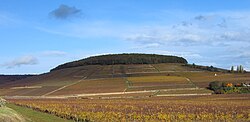
Corton-Charlemagne is an Appellation d'origine contrôlée (AOC) and Grand Cru vineyard for white wine in the Côte de Beaune subregion of Burgundy.[1] It is located in the communes of Aloxe-Corton, Pernand-Vergelesses and Ladoix-Serrigny with Chardonnay, and Pinot Blanc being the only permitted grape varieties.[1] Around 300,000 bottles of white wine are produced each year in the appellation.[2]
Corton-Charlemagne is named after the Holy Roman Emperor Charlemagne, who once owned the hill of Corton on which the vineyards now rest. The first mention of a Clos de Charlemagne dates to 1375, in a lease of the 'Clos le Charlemagne' by the Chapitre de Saint-Androche-de- Saulieu.[3] According to later legend, the vineyards are dedicated to white grape varieties because the emperor's wife preferred white wines as they did not stain his beard.[4] The AOC was created in 1937.[5]
The vines are located on the higher ground of a hilltop that stretches between the Burgundian villages of Ladoix-Serrigny and Pernand-Vergelesses. The slopes planted with the most valuable vineyards face south-east on the hilltop, with the land gradually sloping downwards towards the major French highway Route 74. The red wine appellation of Corton covers the lower part of the hill with the areas for Corton and Corton-Charlemagne partially overlapping. Furthermore, there is a third Grand Cru appellation on the Corton hill, Charlemagne, that may be used for white wine produced from the En Charlemagne lieu-dit. However, as En Charlemagne is only 0.28 hectares in size, production is limited and usually blended with grapes from the other lieu-dits of Corton-Charlemagne.[6][7]
As of 2012, the Corton-Charlemagne AOC was producing an average of 2,280 hectoliters of wine a year (around 304,000 bottles of wine) representing more than 2 out of every 3 bottles of all the Grand Cru class white wine produced throughout the Côte de Nuits and Côte de Beaune.[8] Bonneau du Martray is the largest single owner of vines within the Corton-Charlemagne vineyard with 9.5 hectares.[9]
- ^ a b Journal Officiel de la République Française (25 October 2011). "Cahier des charges de l'appellation d'origine contrôlée "Corton-Charlemagne"" (PDF) (in French). Retrieved 26 March 2013.
- ^ Joseph, Robert (1999). French Wines. Dorling Kindersley. p. 105. ISBN 0-7513-0793-9.
- ^ Coates, Clive (2001). "A Tutored Seminar and Tasting of Corton-Charlemagne and Corton, Domaine Bonneau du Martray, with Jean-Charles Le Bault de la Morinie". Journal of Wine Research. 12 (2): 155–60. doi:10.1080/09571260120095067. S2CID 95243588.
- ^ Matthews, Patrick (2005). Burgundy. Mitchell Beazley. p. 73. ISBN 1-84533-036-6.
- ^ Coates, Clive (June 2001). An Encyclopedia of the Wines and Domaines of France (First Printing ed.). University of California Press. pp. 185–186. ISBN 0520220935.
- ^ Cite error: The named reference
BIVB 2008was invoked but never defined (see the help page). - ^ Norman, R.; Taylor, C. (2010). The Great Domaines of Burgundy (3rd ed.). Sterling. pp. 119 & 255. ISBN 978-1402778827.
- ^ Stevenson, T., ed. (2011). The Sotheby's Wine Encyclopedia (5th ed.). Dorling Kindersley. pp. 200–201. ISBN 9780756686840.
- ^ Johnson, Hugh (2003). Hugh Johnson's Wine Companion. Mitchell Beazley. p. 111. ISBN 1-84000-704-4.
© MMXXIII Rich X Search. We shall prevail. All rights reserved. Rich X Search
